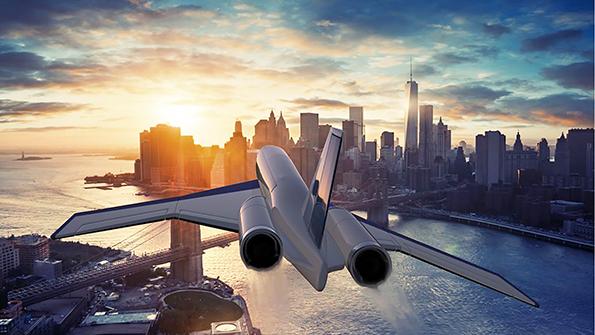
It is easy to forget, but since 2013 a third horse has been in the race to revive supersonic air travel. In that time, Spike has announced none of the progress or types of investment and partnership that have boosted Aerion and Boom Supersonic.
That may be changing. The Boston-based startup has formed a heavy-hitting advisory board and signed an industry partnership with Tech Mahindra, and it plans a Series A funding round to pay for a demonstrator. A huge effort lies ahead if it is to catch up with Aerion and Boom. But as Spike does begin to talk, a different approach to bringing back supersonic travel is emerging.
Aerion is developing the AS2, a Mach 1.4, 8-10-passenger supersonic business jet aimed at service entry in 2026. Boom’s Overture is a Mach 2.2, 65-88-seat supersonic airliner that could begin carrying passengers in 2029. Both must slow down to avoid sonic booms when flying over land.
Spike’s S-512 differs in two ways it considers critical to market success: 18-passenger seats and low sonic boom. The company is aiming for a boom strength at the aircraft’s Mach 1.6 cruise speed of less than 75 PLdB—NASA’s target for public acceptance of supersonic flights over land.
To John Thomas, seasoned airline executive and new member of Spike’s executive team, size and boom set the supersonic startup apart. Formerly CEO of Virgin Australia Airlines and now running a corporate charter operation, Thomas has doubts about the market rationale for Aerion and Boom.
The AS2 competes in a market in which customers value privacy but not necessarily speed since they set their own agendas. They may not see the need to pay more to go faster, he says. And Boom, Thomas argues, is offering too much capacity for the market.
“Concorde told us there is a market that is prepared to pay a premium,” Thomas says. “But it failed because, even on the most lucrative route in the world, they struggled to fill 100 seats. There is a market there, but what is its size?” he asks.
“Airlines are getting rid of first class. The reason is because, given the quality of business class now, you can’t differentiate first class. So how do you differentiate first class? You differentiate by speed,” Thomas says.
“Your classic first-class cabin on a 747-400 is 16 seats, 16-18 seats on an A380. Spike is effectively taking the first-class cabin out of a subsonic aircraft and finally doing some form of differentiation,” he says.
“Airlines have always struggled to fill their first-class cabins because of the value proposition,” Thomas says. “People aren’t prepared to pay for bells and whistles. If you add the speed component, that is a game changer. It’s about matching the right gauge to the market segment. If you’re trying to fill only 18 seats, that opens up all market opportunities.”
After size and speed, a third critical factor is sonic boom. “Low boom that allows you to do supersonic over land massively increases the number of routes you can fly,” Thomas says.
Boom is focused on oceanic routes where the Overture can cruise at Mach 2.2 over water. Aiming for service entry in 2028, Spike is looking at lucrative transcontinental business routes, especially in Asia, where supersonic overland flight is essential. “Now you can do Singapore-Tokyo, Singapore-Sydney as a day business trip,” he says.
“Dubai is a nonstarter for high-boom aircraft,” Thomas says. “If you have low boom, Dubai-London is a day trip. To me, that’s a game changer. Because if you can do that—and not at a first-class fare but a premium-to-business class—the number of people who are going to do that becomes a really interesting opportunity.”
Spike is looking at serving point-to-point routes rather than hubs. “If I’m an airline looking for scale, I’m not going to get it by putting 50-60 people on an aircraft,” Thomas says. “I’d rather have 16-18 people on an aircraft that I’m sending on different routes. If I’m Singapore Airlines, I’m doing Tokyo, Seoul, Sydney, Mumbai, and all of a sudden, I can justify 10 of these aircraft.”
Spike has much still to prove, including the ability to raise funding. President and CEO Vik Kachoria says it is “90% confident” of achieving the low-boom goal after six conceptual design iterations. Wind-tunnel testing of the 4,800-nm-range trijet, planned for the third quarter, “will get us to 95%,” he says. Reaching 100% will have to wait until Spike can fly its manned proof-of-concept aircraft, scheduled for 2022. Entry into service is planned for 2028, which is “optimistic,” Kachoria acknowledges.


Comments
Is there any kind of qualification hurdle for someone who aspires to use Aviation Week as an amplifier for a VC pitch ahead of a Series A round?
Bernard Biales